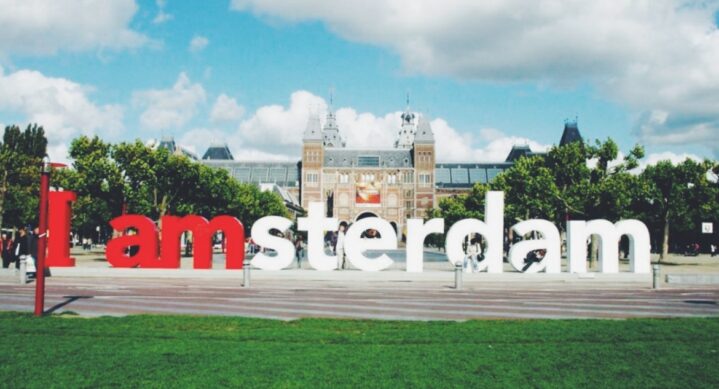
Amsterdam: a modern gem in the heart of a UNESCO World Heritage Site
From ‘Venice of the North’ to ‘City where everything is allowed’, Amsterdam has many names and faces. Actually, the name Amsterdam refers back to the foundation of the city: it was built on a dam in the river Amstel. Ever since a group of farmers and fishermen claimed this small piece of land on the estuary of the river Amstel nine centuries ago, Amsterdam has captured the imagination of traders and travellers.
The former sleepy fishing village was dragged along in currents of history to become the centre of international trade and finance during the Dutch Golden Age in the 17th Century. Nowadays, Amsterdam is most known for its iconic city centre, which is visited by over 4 million foreign tourists every year. Many of them only converge on the picturesque canals and visit famous venues like the Rijksmuseum and Dam Square. However, contrary to conventional thinking, Amsterdam offers far more than its historic city centre. The Dutch capital is an influential modern city that retains its quintessentially Dutch heritage, making it the perfect destination for a short getaway or a longer stay. In this article, real ‘Amsterdammers’ will give you a few insider tips on Amsterdam, focusing on living, leisure and an effortless sustainable day out.
Stress-free living
The capital city of the Netherlands brings together the feeling of living in a comfortable and clean midsized city while having all the perks of a global hub. It therefore is no surprise that Amsterdam was ranked 2nd most child-friendly city in the world by The Telegraph and safest city in Europe by Economist’s 2017 Safe Cities Index. Old working class neighbourhoods around the historic centre like Indische Buurt, De Pijp, de Baarsjes and Overtoomse Sluis offer a wide range of vintage shops, trendy bars and delicious healthy restaurants, and are only a 10 minute bike ride away from the historic city centre.
Living in these areas offers a dynamic experience, as young urban professionals and students keep the neighbourhoods up to date with the latest fads. Hip bars and cosy restaurants are filled with a mixture of young and culturally diverse ‘Amsterdammers’, sipping gin tonics or tasty veggieshakes after working hours. Neighbourhoods in the southern part of the city like Museumkwartier, Apollobuurt and Rivierenbuurt are known for their elegant estates, green parks and marvellous museums. These safe and green neighbourhoods are located right next to the financial district.
Amsterdam is a modestly sized city of around 850,000 people, but punches above its weight in terms of economic power. Ever since the heydays of the Dutch colonial empire, the canal city has been a crucial financial and trade hub. The first stock exchange in the world opened its doors in Amsterdam in 1602, when the Dutch East India Company, the predecessor to the contemporary multinational, issued its first shares. This massive spice trading monopoly was financed by the Bank of Amsterdam, which served as a template for the modern central banks around the world today. Dutch expertise and tradition in international trade and finance has continued to this day: the financial district Zuid-As and the greater southern Amsterdam area are home to a plethora of financial, legal and accounting firms like ING, PWC, Deloitte and KPMG.

Moreover, iconic Dutch multinationals such as Heineken and Philips show the city still attracts and excels in exporting high-end consumer goods. Recognising the economic potential of Amsterdam, international technological firms as Tesla, Uber and Netflix have chosen Amsterdam as their European base. Furthermore, Amsterdam boasts an excellent and internationally-oriented schooling system. A range of international schools offer great education for the very youngest to those in high school. Multiple Dutch secondary schools also offer specialised curricula that allow their students to enjoy all their courses in English. Additionally, two top-notch universities, the University of Amsterdam and the Vrije Universiteit, are located within the city’s borders.
Leisure: How to spend your time in Amsterdam?
Shopping
Amsterdam is known for its hip, out-of-the box boutiques. The city is home to many young designers and contemporary brands. For those that want to discover more than the well-known big retailer brands, Amsterdam is the place to be. Ask any local and they will most definitely refer you to the Negen Straatjes, the ‘nine little streets’. You can find the Negen Straatjes in the middle of the old city centre, surrounded by the canals. The Negen Straatjes were built in the 17th Century, to connect the homes of the rich merchants. Accordingly, some street names refer to the old skin-tanning industry. Although the merchandise of the Dutch Golden Age is not to be found there anymore, you will find authentic designer boutiques, secondhand shops, lunch rooms and fine craftsmanship in the alleys. Make sure not to miss out on this charming part of Amsterdam.
Moreover, markets have been part of Dutch history and culture for a long time. Almost all Dutch cities host a market once or twice a week, with food as the main selling product. Luckily, the Albert Cuyp-market in Amsterdam is open every day of the week. The vibrant and busy market has 300 stalls and is easily accessible by public transport, you can take the tram to Marie Heinekenplein or the metro to Metrostation De Pijp. The prices are among the lowest in Amsterdam, so if you want to take home some Dutch cheese or tulips, the Albert Cuyp provides ample of opportunities. Additionally, you can try the highlights of the Dutch cuisine and get a syrup waffle, some poffertjes (little Dutch pancakes) or a raw herring. If you have the chance, visit the market on a weekday, as it gets crowded during the weekends.
When shopping, please be reminded to take your own bag with you. Not only do plastic bags cost money in the Netherlands, but using own bags is considered part of the Dutch sustainable lifestyle
Food
Although you can find great restaurants throughout the city, a few places are specifically worth mentioning. First of all, there are the Foodhallen in Amsterdam West. The Foodhallen is an indoor food market, where you can try various dishes from both the Dutch as well as the international cuisine. Moreover, the Foodhallen offer Dutch locally brewed beers and have a wine and gin tonic bar. Every Tuesday evening you can enjoy your dinner while listening to live music and on Friday and Saturday evening, life DJ’s will pump up your night. The Foodhallen are open from 11am to 11.30pm, and on Friday and Saturday until 1am. The Volkshotel is a hotel located at the riverbanks of the Amstel River. It was the former headquarter of the Dutch newspaper the Volkskrant, making it a loved place among the city’s writers and creative minded.
The hotel also offers a great culinary experience in its restaurant Canvas, which is located on the seventh floor and looks out on the river. Both hotel and restaurant showcase urban art, which contributes to a hip, modern vibe. Canvas is open every day from 7am to 1am, from breakfast to dinner and everything in-between. On Friday and Saturday night, you can continue the festivities in Club Canvas, open from 11pm to 4am. For those who have had enough of the Dutch cuisine and are longing back to some tasty Asian food, Happy Happy Joy Joy is a perfect match. The restaurant has two locations, in Amsterdam West and Amsterdam East. Besides a trendy Asiainspired interior, both restaurants have a spacious terrace for when the sun is out.
Happy Happy Joy Joy even has a separate gluten-free menu, offering dishes for everyone. The restaurants open at 12pm and close at 1am. If you are looking for a place that is a little bit different, make sure to pass by PUCK. PUCK is the largest air hockey-club of Europe, but also a place with a great ambiance for a nice meal. After trying some food from PUCK’s French-Asian cuisine, you can challenge your friends in an air hockey match at one of the twelve air hockey tables, play GuitarHero or Dance Dance Revolution. PUCK opens every morning at 11am.
Nightlife
As the sun starts to set over Amsterdam, the city of canals shows its second nature. After a long day of shopping and strolling through many of the city’s parks, it’s time to relax and enter one of the many cosy ‘brown cafes’. These local watering-holes have the allure of intimate living rooms and traditionally are the preferred meeting point of hard working ‘Amsterdammers’. Café Gollum is an excellent place to start.
There are four distinct Gollum’s located throughout Amsterdam and every Gollum has a bespoke assortment of beers. Connoisseurs of darker IPA beer are in for a treat at Gollem Raamsteeg, while lovers of a more fresh and light taste will surly enjoy a bottle of Mannenliefde. De Ebeling is another low-key bar, located in a former banking office at Overtoom, a lengthy street of historical value that crosses the city. Try for example its Mokum Mule, a contemporary Dutch variation of the famous Moscow Mule. When the day comes closer to an end, tables and seats will be removed as De Ebeling’s dance floor opens.
Those that are looking for a local-experience clubbing night should hop into Bloemenbar or Disco Dolly. Bloemenbar is open all night, so no matter what time it is, you are welcome. Calling itself the ‘cosiest nightclub in Amsterdam’, expect flowery wallpapers, vintage furniture and a colourful dance floor. Disco Dolly is the place for funky vibes and boogying all night long with Amsterdam’s hottest DJ’s. The doors open a little later, at 11pm, but entrance fees are low to zero.

Out and about: a sustainable day in the city
Apart from Amsterdam’s famous museums as the Rijksmuseum and van Gogh Museum, there is another way to get acquainted with the Dutch culture. Namely, with the Netherlands as a global sustainability pioneer, Amsterdam is the perfect getaway for those caring about the environment. When most people think of the Netherlands, they think of bikes. Indeed, there are more bikes than any other form of transport in the city. It is very easy to rent a bike or to join a biking tour when you are visiting Amsterdam. If you are wanting to explore the northern part of the city and its hip NDSM area, you can be like the locals and use the hybrid electric-ferry ‘het pontje’ to cross the IJ-lake, instead of a car. This free ferry service departs at least five times an hour. You can find the pier behind the central train station.
Furthermore, Amsterdam has some great parks to stroll around, such as the famous Vondelpark, Rembrandtpark and Westerpark, and even has a forest, the Amsterdamse Bos. These green city areas are perfect for a picnic or to read a book. Additionally, children will love the large playgrounds. Occasionally, festivals and open-air theatre performances take place in the parks. When walking through the Amstel Park, you may encounter the Glazen Huis and Orangerie galleries, where art exhibitions are held. If you get hungry, there is a large variety of environmentally friendly options to get a snack or meal. Café de Ceuvel in Amsterdam North is an organic café with a relaxed vibe, hammocks and a green kitchen. It uses kitchen waste to fertilise its garden and fruit trees. Restaurant Pllek, also in Amsterdam North, is located in old harbour containers.
Its dishes are organic, with 75% of the dishes being vegetarian or vegan. Instock is another sustainable option, as the restaurant collects surplus food from local supermarkets to transfer into delicious dishes. It rescues around 2000 kilograms of food every week, converting for example overripe bananas into homemade banana ice-cream. Finally, restaurant De Kas is located in a greenhouse, signatory of the Dutch agricultural heritage. It uses pure and fresh ingredients, of which most are grown by the restaurant itself.
Are you ready for a carefree getaway?
Providing the perfect mix between history and a modern lifestyle, are you ready to discover Amsterdam? The fusion of tradition and progressiveness will make sure you will love wandering through this beautiful global city that feels like a town. Getting around in the city is easy, safe and you don’t have to worry about asking questions, as everyone speaks English. For more information about Amsterdam, please visit www.iamsterdam.com.



